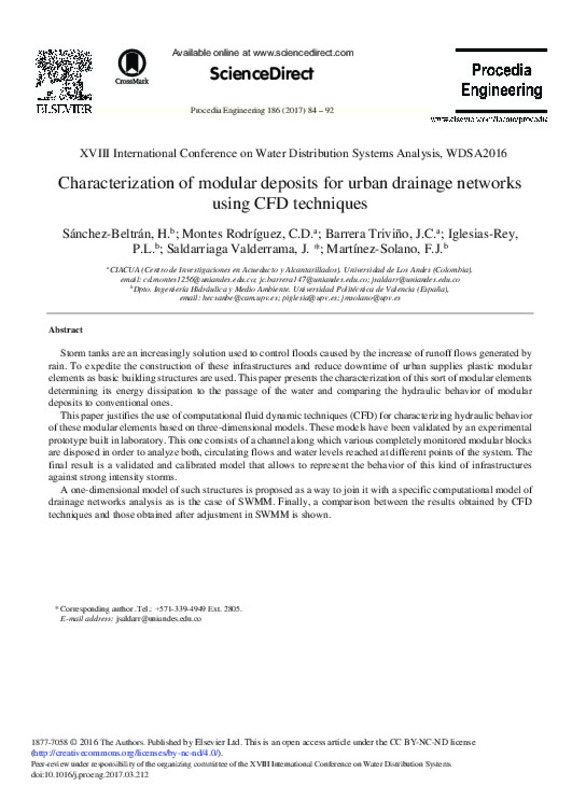JavaScript is disabled for your browser. Some features of this site may not work without it.
Buscar en RiuNet
Listar
Mi cuenta
Estadísticas
Ayuda RiuNet
Admin. UPV
Characterization of modular deposits for urban drainage networks using CFD techniques
Mostrar el registro sencillo del ítem
Ficheros en el ítem
| dc.contributor.author | Sánchez-Beltrán, Héctor
|
es_ES |
| dc.contributor.author | Montes Rodríguez, Carlos
|
es_ES |
| dc.contributor.author | Barrera Triviño, Juan
|
es_ES |
| dc.contributor.author | Iglesias Rey, Pedro Luis
|
es_ES |
| dc.contributor.author | Saldarriaga, Juan
|
es_ES |
| dc.contributor.author | Martínez-Solano, F. Javier
|
es_ES |
| dc.date.accessioned | 2018-04-14T04:20:27Z | |
| dc.date.available | 2018-04-14T04:20:27Z | |
| dc.date.issued | 2017 | es_ES |
| dc.identifier.issn | 1877-7058 | es_ES |
| dc.identifier.uri | http://hdl.handle.net/10251/100428 | |
| dc.description.abstract | [EN] The growing urban development of population centers in much of the world joined with the significant effects of climate change are causing an increasingly important and recurring increase of the damage caused by flooding. Much of the drainage networks of cities were designed for precipitation characteristics and return periods that have proved to be insufficient with the lapse of time. Therefore, solutions need to be addressed both to reduce runoff generated flows as to control circulating ones through the rainwater drainage networks. All these flow control rain technologies are commonly known as SUDS (Sustainable Urban Drainage), term that encompasses a multitude of solutions to control runoff although many of them require significant costs that make them practically unviable. Therefore, not only should focus on reducing runoff input to the network but also in the flow control techniques development. The idea is to design strategies to reduce flow rain peaks and maximize the capacity of existing networks. The use of detention and storm tanks for flood control is a solution increasingly used as an alternative one to control increased rainfall caused by climate change [1]. Nature and execution of storm tanks can be very diverse, from conventional way based on concrete structures to the most innovative ones in which modular structures are employed to improve the construction speed if many modular units are required at the same time that minimizing urban supply disruption is achieved. Currently, a wide range of modular structures exists on the market with both, different geometries and sizes. In this study the Aquacell brand supplied by Mexichem-PAVCO in Colombia shown in Fig. 1 has been chosen for the development of this study. | es_ES |
| dc.language | Inglés | es_ES |
| dc.publisher | Elsevier | es_ES |
| dc.relation.ispartof | Procedia Engineering | es_ES |
| dc.rights | Reconocimiento - No comercial - Sin obra derivada (by-nc-nd) | es_ES |
| dc.subject | CFD | es_ES |
| dc.subject | Sustainable urban drainage systems | es_ES |
| dc.subject | Holding tanks | es_ES |
| dc.subject | Modular tanks | es_ES |
| dc.subject.classification | MECANICA DE FLUIDOS | es_ES |
| dc.title | Characterization of modular deposits for urban drainage networks using CFD techniques | es_ES |
| dc.type | Artículo | es_ES |
| dc.type | Comunicación en congreso | es_ES |
| dc.identifier.doi | 10.1016/j.proeng.2017.03.212 | es_ES |
| dc.rights.accessRights | Abierto | es_ES |
| dc.contributor.affiliation | Universitat Politècnica de València. Departamento de Ingeniería Hidráulica y Medio Ambiente - Departament d'Enginyeria Hidràulica i Medi Ambient | es_ES |
| dc.description.accrualMethod | S | es_ES |
| dc.relation.conferencename | 18th International Water Distribution Systems Analysis Conference (WDSA 2016) | es_ES |
| dc.relation.conferencedate | July 24-28,2016 | es_ES |
| dc.relation.conferenceplace | Cartagena de Indias, Colombia | es_ES |
| dc.relation.publisherversion | https://doi.org/10.1016/j.proeng.2017.03.212 | es_ES |
| dc.description.upvformatpinicio | 84 | es_ES |
| dc.description.upvformatpfin | 92 | es_ES |
| dc.type.version | info:eu-repo/semantics/publishedVersion | es_ES |
| dc.description.volume | 186 | es_ES |
| dc.relation.pasarela | S\355784 | es_ES |








